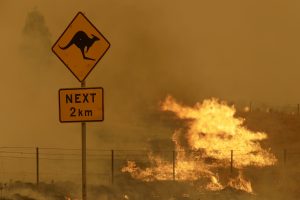At the beginning of 2020, Australia’s catastrophic bushfires were making international headlines. The scale and devastation of the fires is difficult to exaggerate. By the time the worst had passed, some 30 people had lost their lives directly, with hundreds more killed in the smoke haze that blanketed some of the country’s largest cities. Millions of hectares of bush and forest had been burnt, over 1 billion animals had perished, and the recovery bill was into the billions. Australia called up its armed forces, states of disaster were declared, and the federal government announced a royal commission into the effectiveness of preparation and response.
Amidst stories of tragedy and heroism, a range of accounts emphasized the important role of climate change. Among other effects, climate change causes an increase in the intensity and frequency of extreme weather events, including bushfires. In the case of a country like Australia, higher temperatures associated with climate change serve to increase the number of “high risk” fire days over the course of a year. It also increases the volume of dry soil and fuel, while limiting the time window for carrying out fuel reduction burning to minimize the threat. Analysts noting the climate link were quick to point out that climate change had arrived in Australia, with the country experiencing its hottest year on record in 2019 at more than 1.5 degrees Celsius above Australia’s long-term average.
On the back of long-term drought and natural disasters, it is perhaps unsurprising that the scale of the threat posed by climate change seems to be one recognized by the Australian public. Surveys such as the Lowy Institute Poll have indicated growing concern about the implications of climate change, with climate change topping their 2019 survey on key threats to Australia’s national interest. Even since the coronavirus pandemic commenced, appearing to draw attention away from the challenge of climate change, an October 2020 Australia Institute poll indicated that 80 percent of Australians thought we were already experiencing problems caused by climate change, while 83 percent supported closing coal-fired power stations.
Yet despite the reality of the threat posed and the growth of public concern about it, Australia is at best a laggard on global climate action, and at worst a pariah. The current national government heavily subsidizes the fossil fuel industry domestically, while aggressively promoting fossil fuel exports internationally. Canberra’s Paris Agreement commitments of a 26-28 percent reduction in emissions by 2030 are comparatively unambitious, and even then will only be realized with a generous (and controversial) use of carry-over “credits” from the Kyoto Protocol. Australia is also part of a rapidly shrinking minority of major economies (and emitters) refusing to commit to achieving net zero emissions by the middle of the century. Australia, it would seem, is both near the “front line” of climate change and a significant part of the failure to adequately address it.

































